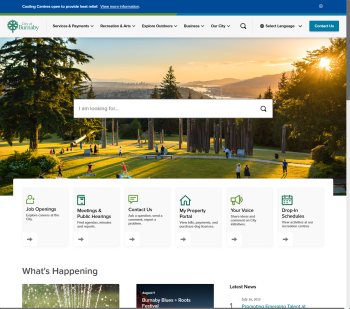City of Burnaby
Overview
Burnaby, incorporated in 1892 and city-status achieved in 1992, is the third-largest city in British Columbia with a 2021 population of ~249,000. Positioned centrally in Metro Vancouver, it spans around 96.6 km² and balances urban growth with about 25 % of land dedicated to parks and green spaces.
Key Features
- Natural assets: Includes Central Park, Burnaby Mountain, Deer Lake, Barnet Marine Park, and extensive creek and river corridors supporting recreation and biodiversity.
- Urban centres: Four town centres—Metrotown, Brentwood, Lougheed, Edmonds—built around SkyTrain stations, offering major shopping, density, transit connections, and mixed-use development.
- Education & Innovation: Home to SFU and BCIT, and a growing hub for tech firms (e.g., Ballard, D‑Wave) and film studios (over 60 % of BC’s sound stages).
- Culture & recreation: Operates Burnaby Village Museum, Michael J. Fox Theatre (in discussion for joint management), public libraries, and diverse community and sports facilities.
Services & Governance
- City Council and staff deliver services such as public safety, engineering, planning, recreation, waste management and emerging district energy systems (e.g., Burnaby District Energy Utility linked to Metro Vancouver’s waste-to-energy network).
- In 2025, new zoning bylaws were adopted to simplify multi-family and commercial development via height-based zones.
- Recognized as “Best-Run City in Canada” by Maclean’s, though voter turnout remains low (~26 %).
Infrastructure & Sustainability
- Committed to climate action—declared a climate emergency in 2019 and investing in district energy systems for thermal efficiency.
- Extensive SkyTrain network supports urban growth with major commercial and residential nodes; bus system operated by TransLink integrates across Metro Vancouver.
Challenges & Opportunities
- Growth demands balanced with housing affordability, green space preservation, and redevelopment of town centres.
- Climate resilience and energy transitions through initiatives like district energy and sustainable zoning.
- Cultural infrastructure expansion (e.g., Michael J. Fox Theatre) speaks to ongoing community planning and partnerships with Burnaby School District.
Verdict
Burnaby excels in combining urban dynamism with environmental assets, delivering robust public services and embedding sustainability in development plans. As it continues densifying transit hubs, key areas to watch include housing diversity, green infrastructure, and co-governance on cultural venues.
Visit Website
Scan to visit

